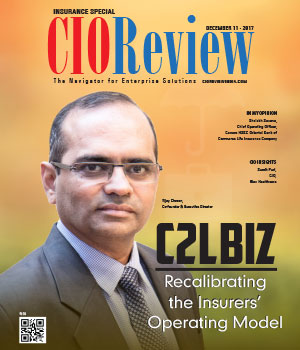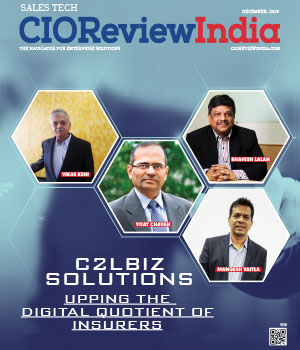
Significance of Customer-centric Digital Experience in the Insurance Industry
Janifha Evangeline | Friday, 23 June 2023, 20:17 IST

Sachin Dutta, Chief Operating Officer, Canara HSBC Life Insurance in an interaction with CIOTechOutlook shares his views on the challenges faced by the insurance industry in providing a customer-centric digital experience, the role personalization and customization play in creating a customer-centric digital experience in the insurance industry, and more.
What are the biggest obstacles faced by companies in the insurance industry when it comes to providing a customer-centric digital experience?
While the insurance industry is an age-old construct that has stood the test of time, its consumption has been comparatively slower in India vis-à-vis our Western counterparts. However, the onslaught of the pandemic changed people’s perspective - it spurred renewed interest while at the same time, there was increased awareness around traditional insurance enabling an unprecedented and rapid increase in the uptake of digital communication modes, and augmented disposable income levels – thus providing consumers the option to direct their money towards various investment options basis their risk-appetite and life-goals (including insurance).
The Indian insurance sector got the desired impetus in the early 2000s after privatization heralded the era of new entrants. Backed by FDI, and powered with the ambition of capturing a market that had just started taking baby steps in the world’s most populous nation, these organizations, slowly yet steadily gained momentum to redefine the way India perceived and consumed insurance products. This backstory is critical to realize the fact that insurance as an industry has only begun to spread its roots in India’s ecosystem in the last couple of decades or so and that it’s still in its nascent stage of evolving, learning, and adapting – with a participation of a mere 4.2 percent of the country’s citizens in FY 2021.
Quite interestingly, the adoption of innovation driven by major developments in the world of technology has opened up a world of opportunities for creating a digitally-driven ecosystem.
While many may want to perceive it as an obstacle, I personally see a lot of factors that are, in fact, driving the customers’ preferences toward digital means.
The way the internet consumption pattern and penetration have shown a shift, (translating into massive economies of scale), significantly bringing down the cost of data (as compared to other countries), growing consumer appetite and preference for digital mediums including WhatsApp, millennials’ rapid adoption of digital tech, as well as the expansive reach of digital payment systems (e-wallets/UPI and more) to the remotest parts of the country, are playing a major role in driving the evolution of digitally-driven service mechanisms which will certainly take center stage in the near future.
For me, the gaps are actually growth opportunities that will steadfast on our journey to expand our customer base, and, more importantly, help us ensure that every Indian is sufficiently insured, with a complete understanding of insurance as one of the finest financial protection tools.
What role do personalization and customization play in creating a customer-centric digital experience in the insurance industry, and how can companies effectively tailor their digital offerings to meet individual customer needs and preferences?
Let me put across a question. If I offered you a 4-course meal, including the world’s most expensive dishes, without knowing that you would perhaps prefer a simple Fish-n-Chips platter, I would definitely be wasting my money, time, and efforts on something which may have been grand for me but is probably worth nothing to you.
That is exactly how the power of personalization and customization unfolds in the insurance industry. We need to know our customers’ preferences, behavior, and preferred communication modes to ensure that our marketing and operational spending are actually translating into strong outcomes and yielding the right results for our business uptake.
While the last statement effectively addresses your question in entirety, I also believe that companies need to leverage big data insights, the voice of customers, and general industry trends to truly understand, appreciate, and finally deliver the level and scale of personalization that their customers expect from them.
A key aspect here is the element of KYC (Know Your Customer); its virtues lie far beyond the simple regulatory aspect. If we are able to clearly identify and assess the needs of our customers, in line with their life goals/risk appetite/financial requirements, we will be able to create products that are truly holistic and all-encompassing ensuring greater persistence and brand loyalty from our customers.
How can insurance companies balance the need for automation and efficiency with the desire to create a personalized, human-centered experience for customers navigating digital platforms?
The solution is very simple: aspiring to strike the perfect balance between automation and human intervention. When we say ‘aspire’, we allude to the fact that perfection – even though considered a utopian, ideal state of things – is primarily a journey that we need to cover celebrating every milestone on the way.
I would say that the industry, as a whole, is at a beautiful inflection point in this journey. While the advent of generative AI has given a fillip to the automation geeks – who are always bullish on the idea of creating a robotic, tech-only service delivery system – which may bring cost efficiencies and scale our operating mechanisms. While driving all this, we must not forget that all our efforts, time, and resources are focused on delivering value to people – real human beings – who always need that touch of trust, empathy, faith, and hyper-personalization.
That is why I believe that even while we are building tech-enabled ecosystems we should integrate the solutions with a thoughtful and personalized human touch.
How can companies effectively leverage data and analytics to better understand customer behavior and preferences, and use this information to build more engaging and meaningful digital experiences?
In my opinion, I would say that we should perpetually be in the Learn-Implement-Validate-Deliver mode.
Learning from data and insights, implementing the analysis and extrapolating the learning to real-time delivery scenarios, validating the same from a feasibility-to-implement perspective, and finally creating a delivery mechanism basis for the overall filtration process – that has been our mantra for success at Canara HSBC Life Insurance.
While there are a million and more machine learning tools available in the market all of which are capable of churning tons of actionable insights, we need to know exactly what our target market is, the factors that influence it, and the stimuli which will drive people to take affirmative action within the domain.
If we shore up our understanding of these key business pillars, we will be able to leverage those insights to create positive outcomes – for our business and customers alike.
What role do emerging technologies such as AI, machine learning, and chatbots play in the evolving landscape of digital customer experience in the insurance industry, and what challenges or opportunities do they present for companies?
Let us take this up from two diverse-yet-unified perspectives. Generative AI is being touted as the ‘next big thing’ in the industry – and rightly so.
With its automation-driven, human-like capabilities, it offers tremendous opportunity for businesses to scale up, modernize and revamp their service delivery infrastructure at possibly a fraction of the original cost. This further translates into lower operating cost, opportunities to recalibrate your existing manpower model, and hyper-personalization aimed at ensuring customer delight.
However, if you factor in the inherent restrictions of the data pool (which AI will use to generate responses), the innate, subtle biases (capable of creeping in, depending on the developers and coders who feed inputs to the respective tech), and the lack of human touch with zero visibility on your situation, needs and circumstances, then your best laid-out AI plans will be set up for long-term failure vs short-term success.
That’s precisely why I said that we are at an inflection point in the journey of digitization. As an organization, and perhaps as an industry, we need to wait and watch as AI matures, encompasses broader use cases, and is able to deliver purely objective solutions aimed at ensuring customer delight.
What steps can companies take to foster a culture of customer-centricity across all aspects of their operations, from product design and development to marketing and customer service, and how can digital solutions support this goal?
As Canara HSBC Life Insurance completes 15 years in the industry, my journey has taught me that one should not expect the outcome to be dependent on actions – they are dependent primarily on experiences.
Simply speaking, one may forget what someone did for them – but they will never forget how it made them feel; That feeling is precisely what we – as individuals, and as an organization need to convey effectively to our customers, stakeholders, and partners.
With most non-customer-facing employees our actions or commitments may never have a direct impact on customers, we need to change that age-old perception and prejudice through strategic training interventions (sales/front-ending staff) to inculcate a culture of customer-centricity, enabling an employees-as-customers working methodology – wherein we strongly encourage our people to purchase our policies, to be able to view the entire promise fulfillment process from the customer’s perspective, and, get a first-hand view of the queries/concerns which customers are likely to experience during their journey with us, developing a customer-first culture and line of thought within our bank partners and digital channels, tapping cutting-edge digital tools and leveraging their intuitive capabilities to deliver excellent outcomes from each customer interaction, conceptualizing and disseminating a constant flow of messaging around customer-centricity – driven by the leadership, and cascaded to our foot-soldiers at the last mile.
To conclude, I would simply say that culture isn’t a standalone entity and definitely cannot drive in silos. It is driven by employee buy-in across all levels of an organization. Personally, I feel that it is an ingrained way of working, built on the foundation of your guts, instinct, and passion, and doing what is right.
CIO Viewpoint
Insurance Tech Trends: Moving from Brick to...
By Dheepak Rajoo, Chief Information Officer, Royal Sundaram General Insurance
Easing the access to insurance with...
By Ayan De, Chief Technology Officer, Exide Life Insurance
Does an Organization's Digital Journey Warrant...
By Mudit Agarwal, Global IT Head, Uflex
CXO Insights
Significance of Customer-centric Digital...
By Janifha Evangeline
How tech will shape insurance operations in...
By By Ayan De, Chief Technology Officer, Exide Life Insurance
Transforming the Insurance Sector with Low Code




.jpg)
.jpg)





